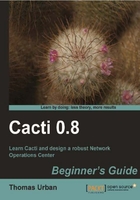
Generally speaking, network management refers to the tasks associated with running a network, along with the software, tools, and technology required to support these tasks. One major part of running a network is to monitor the devices on it in order to know what is happening.
One definition of network management from the ISO Telecommunications Management Network model and framework for network management is known as FCAPS. It divides network management into five disciplines: Fault, Configuration, Accounting, Performance, and Security. Most network management tools can be assigned to one of these disciplines and, out of the box, Cacti is generally more of a performance measurement tool than a management tool, but it can be enhanced to also perform additional tasks.
Cacti is an open source performance measurement and graphing application. The first version of Cacti was published on 23rd September, 2001, and provided a complete web-based frontend to RRDtool, the high performance data logging and graphing system created by Tobias Oetiker, two years earlier. Cacti stores all of the information required to gather this data and create the graphs in a MySQL database, all of which is completely configurable via its web interface.
For data gathering, Cacti uses external scripts and commands, as well as all 3 SNMP versions.
Even in its initial release, Cacti included much of the functionality needed for an enterprise class performance measurement tool:
- Complete web-based RRD and RRA management
- Complete RRD Graph configuration and generation
- With external Script/Command and SNMP support
- With easy configuration for SNMP interface data graphing
- With granular user rights management
From an architectural point of view, Cacti uses a cron/at-based poller to gather data from different sources, Round Robin Database (RRD) files to store the polled data, and a MySQL database to store the systems configuration. The primary user interface is a PHP web application that allows for easy management of all aspects of the system, as well as automatic display mechanisms for viewing the graphs.
Cacti is available for different operating systems such as Windows, Linux, and Solaris.
Although the main area for which Cacti is used is performance measurement, it can be extended to do much more! With the introduction of the Plugin Architecture, Cacti can be extended to include tasks such as:
- Threshold alerting
- Real-time monitoring of specific data sources
- Creating and sending scheduled reports
- System logging and analysis
- Performing network configuration backups
- Integration of other network management software
- Tracking network hardware
Many of these extensions or plugins are actively maintained and supported by the Cacti Group itself, while others are maintained by the Cacti community and the developer of each extension.